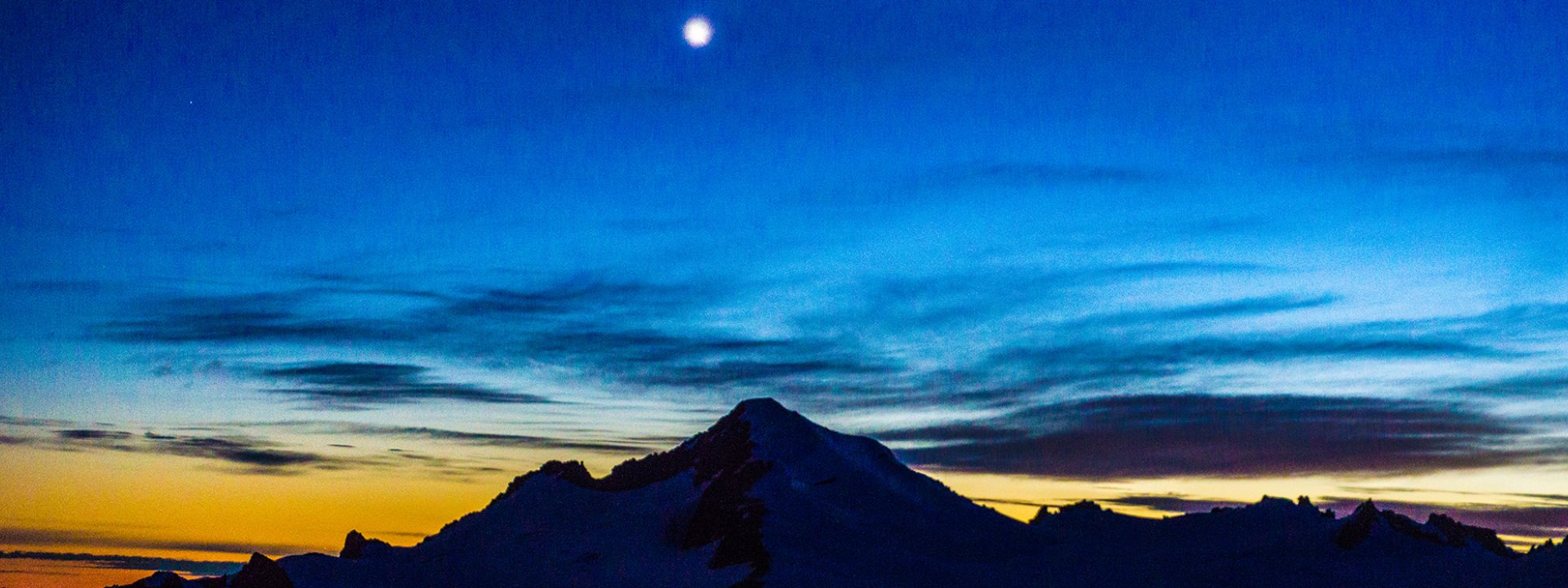Clothing
This is a general equipment list for alpine rock climbing in the North Cascades. Please contact your guide for more specific recommendations for clothing and gear. For clothing we recommend you carry items that are breathable, allow flexibility, reisist wind and water, and based on a layering system. If you have any questions please contact our office or your guide.
- Approach shoes - Ideally a pair of shoes with sticky rubber but a sturdy pair of running shoes will also work. Early season you may need to use boots with lightweight crampons. Please confer with your guide on the appropriate footwear.
- Gaiters –Early season ankle high gaiters or pants with gaiters are recommended.
- Socks – Wool or synthetic. Avoid cotton. A single heavy weight pair is best. A pair of liners with a medium sock also works well.
- Pants – Synthetic preferred. Pants made from Schoeler Fabric such as Patagonia’s “Simul Alpine” pants are great options.
- Long Underwear top - bottoms may be needed in the early season.
- Lightweight shirt – A lightweight fleece (Patagonia’s R1) or wool shirt.
- Insulated Jacket – Synthetic, pile or wool. Patagonia’s “Nano Puff” or similar synthetic is a great option as its lighter, warmer and more packable than fleece.
- Shell gear – Gore-tex parka with hood and pants as lightweight as possible. These are usually not necessary but on stormier days can be useful.
- Gloves- an lightly insulated pair of leather gloves are recommended.
- Sun hat – Quick drying preferable.
- Warm Hat – A wool or fleece ski hat that fits under your helmet.
Climbing Gear
- Climbing Harness – A versatile, lightweight harness is best. Ideally one with a belay loop and adjustable leg loops. Gear loops are critical on the harness.
- Carabiners – Bring 2 lockers and 2 non lockers.
- Belay/ Rappel device -Plate type device like the Black Diamond ATC or the Petzl Reverso.
- Rock Shoes – These should be comfortable shoes that can ideally be worn with thin socks.
- Helmet – Must be specific for climbing/ mountaineering.
Miscellaneous Gear
- Pack -Around 2,000 cubic inches or about 30-35 liters is ideal. Much bigger and the pack gets too heavy and does not climb well. This is merely a day pack as you won’t be carrying camping gear.
- Headlamp – A simple LED model will work fine.
- Lunch Food - A large lunch that includes high energy snacks such as GU, and energy bars.
- Water bottles – Carry at least a quart. Many people like to carry 2. Collapsible bottles like the platypus take up less room in your pack as you drink water. Hydration bladders work well.
- Sunscreen/ lip protection – SPF higher than 30. A small tube should last the entire trip.
- Sunglasses – With 100% UV protection. Consider wearing with retention straps. Changeable lenses are great for variable light conditions. Smith’s slider series offers this option. Dark lenses are a must and many people use side shields as well.
- Personal med kit – Mostly just for blisters and hotspots. Molefoam, athletic tape and Spenco’s second skin all work well. Your guide will carry some of this, but bring some of your own if you are prone to foot issues. You may also want to consider bringing a small amount of Tylenol or ibuprofin, antacids (ie- Pepto Bismol, Rolaids) and a few Bandaids.
- Pocket Knife – Simple and Light. Mostly just for cutting bread and cheese.
Optional Gear
- Trekking Poles – Adjustable poles are great for improving balance, saving energy and sparing your knees. The 3 section poles or the new tent pole style poles like the Black Diamond Z-Pole are nice because the fit inside your pack while climbing technical terrain. Keep them fairly short so that your hands are below your navel when standing on flat ground. HIGHLY RECOMMENDED!
- Camera- Most likely you will want to document this great adventure. Try to get a carrying case that fits on your pack and will not interfere with your climbing. If you keep your camera inside your pack you won’t take many pictures.
- Shorts and t-shirt - in warm weather these are essential.
- Ice axe and crampons - these are necessary in the early season (roughly May - late June). Please contact your guide to confirm whether or not these items are necessary
Category



